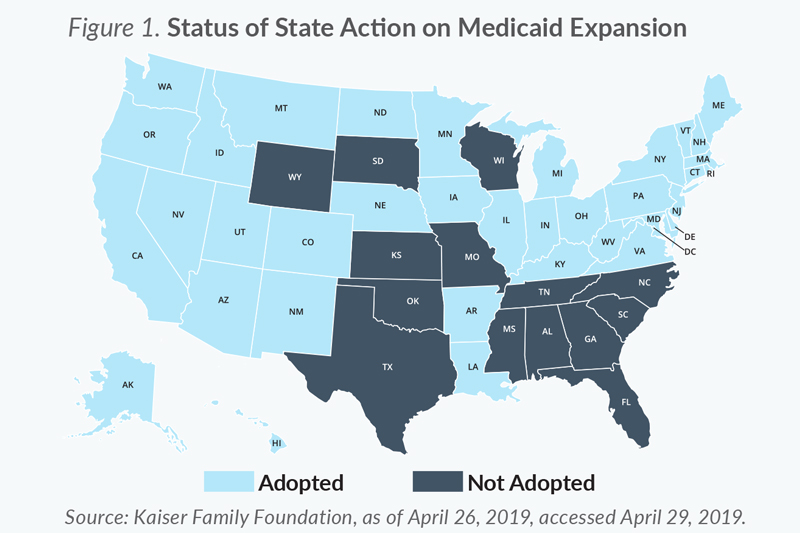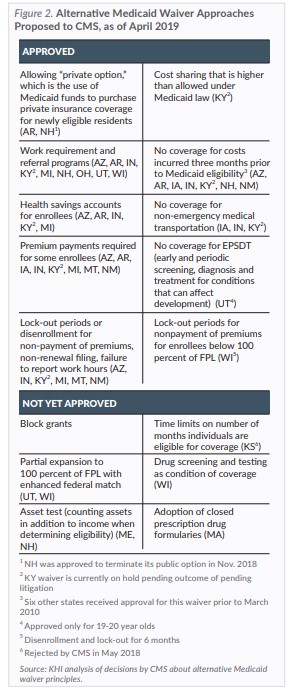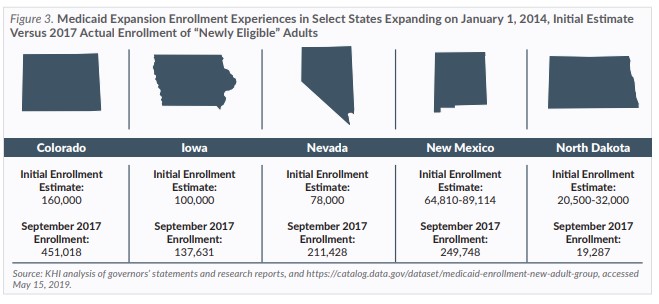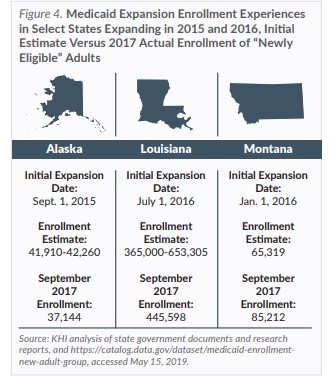In fiscal year (FY) 2015, total Medicaid spending growth in expansion states far exceeded growth in non-expansion states. Across the 29 expansion states (including D.C.) in FY 2015, total spending increased by 17.7 percent. Across the 22 states not implementing expansion in FY 2015, total spending growth was 6.1 percent.
After the large increases in spending in 2015, growth of total Medicaid spending slowed in SFYs 2016 and 2017 for both expansion and non-expansion states. For 2016, the median rate of growth in total Medicaid spending in expansion states was 7.1 percent compared to 3.8 percent for non-expansion states.
Beginning in SFY 2017, state spending growth began to rise as expansion states were required to start paying 5 percent of the costs of their newly eligible adult enrollees on January 1, 2017. Most states have reported they are financing the state share of expansion costs with general fund dollars, while a few states have listed other sources of financing, including new or increased provider taxes/fees or other savings that accrue from the expansion.
How Expansion Affects Health and Quality of Life
In a study published in the journal Health Affairs in June 2018, the authors analyzed 77 studies published since 2014 addressing the association between ACA Medicaid expansion and changes in health insurance coverage, access to care, health care costs and patient outcomes. While some of the studies reviewed by the authors reached differing conclusions, overall they found:
-
- Expansion was associated with an increase in insurance coverage among all potentially eligible individuals, including major racial, ethnic, age, marital status and income groups, with the largest coverage gains for adults without a college degree.
- Improvements in appointment availability or wait times followed expansion.
- The share of adults who reported problems accessing care due to cost and problems paying medical bills in the past year decreased.
- The likelihood of U.S. citizens age 19-64 with incomes below 138 percent of FPL having a personal physician increased and reliance on the ED as a usual source of care decreased.
- Expansion was associated with an increase in the use of primary care, mental health and preventive visits among Medicaid enrollees, but studies showed mixed results regarding hospitalization and emergency department (ED) visits. Several studies showed decreases in hospitalizations and hospital lengths of stay among newly insured Medicaid enrollees, while others reported increases in hospitalizations and ED visits.
- There were improved glucose monitoring rates for patients with diabetes, better hypertension control, improved rates of prostate cancer screenings and higher rates of Pap testing.
- There were reductions in self-reported rates of psychological distress and days of poor mental health.
While it is too early to have much of the data needed to fully understand the impact, early studies suggest that states that expanded Medicaid had a significantly smaller increase in cardiovascular mortality rates among middle-aged adults and have shown modest improvement in access to cancer treatment, including higher rates of diagnosis and treatment of patients with certain cancers at earlier stages. Other recent studies found that expansion has reduced the percentage of people with medical debt and the probability of new bankruptcy filings related to medical debt.
Impact on Safety-Net Hospitals
For safety-net hospitals, including public hospitals, academic medical centers and certain private hospitals, recent studies suggest there have been reductions in uncompensated care and improved financial status of hospitals in states that have expanded Medicaid compared to those in states that have not. In a study published by the Commonwealth Fund in November 2017, the authors looked at the changes in financial status of 326 hospitals in states that expanded Medicaid prior to 2015 compared to 268 hospitals in states that did not expand or expanded in 2015 or after and found:
-
- Operating margins for safety-net hospitals in Medicaid expansion states improved compared with declines for those in states that did not.
- From 2012 to 2015, safety net hospitals in expansion states experienced larger growth in Medicaid utilization than those in non-expansion states, including a rise in inpatient days of 13.5 percent compared with a decrease of 0.9 percent for hospitals in non-expansion states.
- From 2012 to 2015, safety-net hospital Medicaid revenues as a share of net patient revenues rose 12.7 percent in expansion states compared to a 1.8-percent decline in non-expansion states.
- Profit margins on Medicaid patients fell from 6.8 percent to 0.7 percent at safety-net hospitals in expansion states, suggesting revenues for the newly eligible patients did not keep pace with the cost of treating them.
- By 2015, uncompensated care costs among safety-net hospitals declined from 6.7 percent in 2012 in expansion states to 3.5 percent (a 47.4-percent reduction), compared to a decline from 5.7 percent in 2012 to 5.3 percent in non-expansion states.
Economic Effects
Multiple studies suggest that Medicaid expansion can result in offsetting state costs in other areas, including costs related to behavioral health services, crime and the criminal justice system, and Supplemental Security Income program costs. For example, a study in Montana revealed that as the Medicaid role in financing substance use disorder (SUD) services has grown under expansion, federal Medicaid dollars have replaced federal block grant and state dollars previously used to fund services for uninsured Montanans with SUD, freeing up these dollars to be reinvested in Medicaid and other state priorities.
Research suggests that Medicaid expansion also may contribute to lower marketplace premiums. A study in Arkansas showed that the private option has increased the number of carriers offering marketplace plans statewide, generated a younger and relatively healthy risk pool and contributed to a 2-percent drop in the average rate of marketplace premiums.
For the effects of expansion on employment, a study in Colorado found that growth in the economy, as a result of Medicaid expansion, added more than 31,000 additional jobs as of SFY 2015. A study in Kentucky has estimated expansion will create over 40,000 jobs in the state through SFY 2021. In early 2017, researchers projected that additional employment associated with increased Medicaid spending in Michigan beginning in 2014 will yield approximately $145 million to $153 million annually in new state tax revenue, which nearly would offset all the projected new spending by the state for expansion in 2017 and 37 percent of costs in 2021.
In Ohio, most expansion enrollees who were unemployed but looking for work reported that Medicaid enrollment made it easier to seek employment and over half of the expansion enrollees who already were employed reported that enrollment made it easier to continue working. No studies have found any negative effects of expansion on employment or employee behavior, such as transitions from employment to non-employment or from full- to part-time employment.



